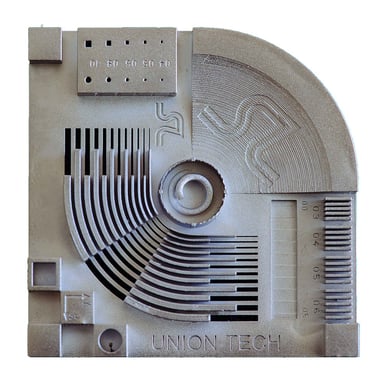By Jim Reitz, General Manager of Union Tech, Inc.
Hype is no stranger to the 3D printing/additive manufacturing marketplace. It is understandable, then, that personnel responsible for implementing AM capabilities often have a healthy degree of skepticism or even confusion regarding the best use of their investment dollars.
Perhaps the most important criteria when considering an initial or additional AM equipment purchase is “How can this purchase add to my efficiency, cost-effectiveness, and overall part production capabilities to meet current and potential future requirements?” There are applications that are well defined, such as dental, where a narrow, specialized solution is indeed the best solution. However, given the ever-expanding range of application possibilities based on material and software developments, versatility and adaptability of the selected technology are indeed important parameters to evaluate.
A simple filter to evaluate your next 3D printing/AM equipment purchase is the question: “Can your equipment do this…?
Can it make large, complex parts?

 Can it build extremely small parts or enable highly detailed features in larger parts?
Can it build extremely small parts or enable highly detailed features in larger parts?
Can it produce full density, non-porous parts and extremely smooth surfaces with exacting detail and resolution?
Can it produce light-weighted structures with hollow, reinforced sections?
Can it utilize materials that produce parts ranging from high clarity and colorless to the pigmented aesthetic of injection-molded materials? Can it utilize materials that produce parts with mechanical and physical properties ranging from tough, flexible polypropylene-like to robust ABS-like and glass-filled polycarbonate?
Can your equipment be utilized to create a wide range of smooth, precise casting patterns, robust jigs and fixtures, wind tunnel test models, metal-clad composites with near die-cast aluminum properties, and tooling for a range of plastic-forming processes?
Can you access the largest installed base of service providers and one of the largest bodies of application expertise for additional support or capacity?
For stereolithography equipment, the answer to all these questions is yes!
Why UnionTechTM?
UnionTech SL equipment is designed for cost effectiveness throughout the ownership cycle while consistently enabling production of parts with exceptional aesthetics, including impressively smooth sidewalls straight out of the machine. UnionTech SL’s open design allows users to choose the best and most cost-effective software and materials for their application.
Union Tech Inc.
Established in 2000, the UnionTech brand of photopolymer 3D industrial printing equipment is now the domestic China market leader in stereolithography. In 2016, the formation of Union Tech, Inc., in St. Charles, Illinois, a fully owned subsidiary of Shanghai Union Technology Corporation, marked our expansion into North America. International distributorships and agents have also been established throughout Europe and Russia. RP Sales America is the US distributor for Union Tech Inc. equipment.
For more information about the UnionTechTM equipment available in the United States: https://uniontech3d.com/

